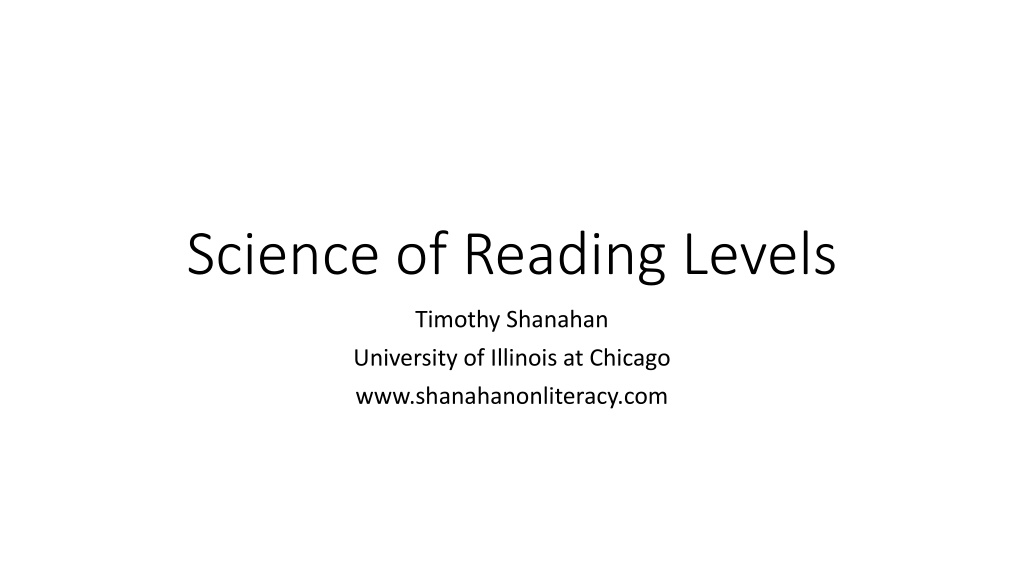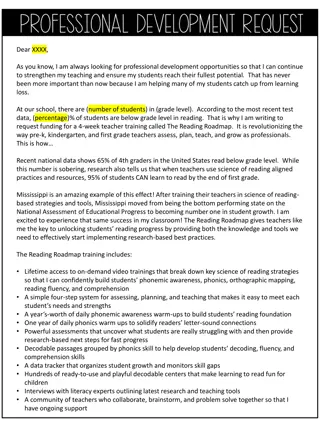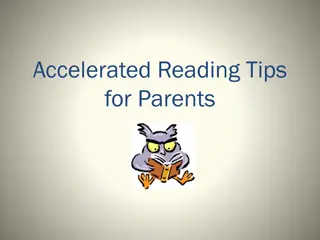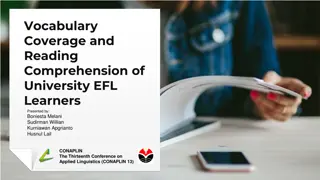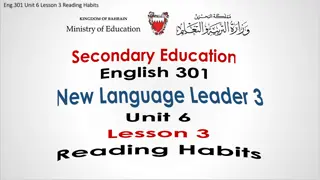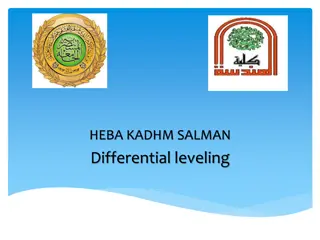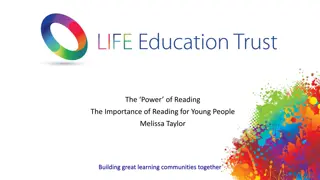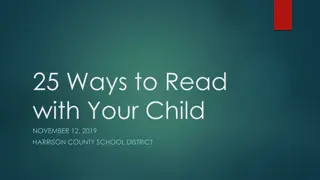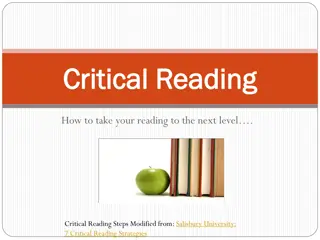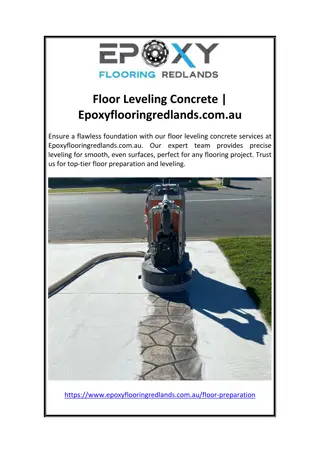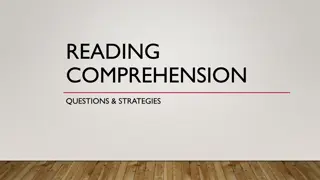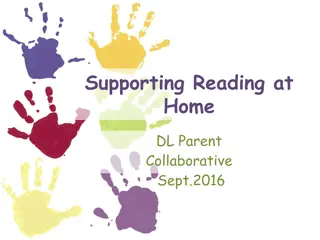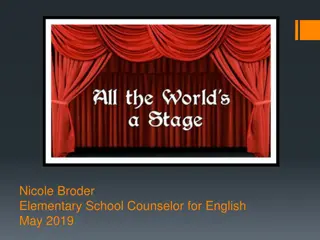Evolution of Book Leveling in Reading Education
Book leveling, tracing back to Aristotle, has been a key aspect of American reading education, evolving from subjective assessments to scientific readability studies. The concept of text difficulty along a continuum and student reading ability coordination has played a vital role in facilitating effective teaching and learning practices over the years.
Download Presentation

Please find below an Image/Link to download the presentation.
The content on the website is provided AS IS for your information and personal use only. It may not be sold, licensed, or shared on other websites without obtaining consent from the author.If you encounter any issues during the download, it is possible that the publisher has removed the file from their server.
You are allowed to download the files provided on this website for personal or commercial use, subject to the condition that they are used lawfully. All files are the property of their respective owners.
The content on the website is provided AS IS for your information and personal use only. It may not be sold, licensed, or shared on other websites without obtaining consent from the author.
E N D
Presentation Transcript
Science of Reading Levels Timothy Shanahan University of Illinois at Chicago www.shanahanonliteracy.com
Book Leveling History The idea that texts vary in difficulty along a continuum can be traced back to Aristotle The role of such a continuum in teaching came to America on the Mayflower (Protestant Tutor) The idea that students should be taught with texts that start simple and grow more challenging over time has consistently been a part of American reading education New England Primer Webster s Blue Back Speller McGuffey s Eclectic Readers
Book Leveling History (cont.) Leveling was an idea widely shared among printers, publishers, and educators evidently based on the premise that learning proceeded from simple to complex Their control of this complexity continuum was either subjective or they had methods for this that were unstated These efforts increased with the introduction of age graded schools in 1837 This kind of informal leveling continued into the 20thcentury
Book Leveling History (cont.) 1910s marks the beginning of the measurement movement The basic idea was that it was possible to evaluate human skills and abilities on various continuum and that this would have pedagogical value 1915 William S. Gray publishes first reading measurement the Standardized Oral Reading Paragraphs Grades 1-8 Other informal methods of assessment begin appearing in educational journals
Book Leveling History (cont.) An early survey (1918) indicated that 6% of primary teachers tested their students reading rate and comprehension, 58% taught reading in small ability groups, and 42% used graded reading materials to differentiate instruction Student placement for the most part were based on subjective and unstated methods (e.g., Laura Zirbes) This shows early recognition of the idea that text difficulty represented a continuum, student reading ability represented a continuum, and that the coordination of these continua could facilitate teaching and learning
Book Leveling History (cont.) Psychologists began the scientific study of text readability (Lively & Pressley, 1923) This was an attempt to objectively identify text features that could be measured for the purpose of predicting reading comprehension or to place books on a continuum of difficulty Initially, they tried to identify all structural text features that contributed to text difficulty, but because of the difficulties of measurement and shared covariance among variables they eventually focus on efficiency (2 variables) Despite the increasing availability of readability schemes, the control of reading challenge in basal readers was determined almost entirely on rigorous vocabulary controls (with stories written for the purpose of teaching) These vocabulary controls led to inauthenticity of language and negative reactions
Book Leveling History (cont.) From 1910-1940, there are occasional mentions of the idea that students should be taught at their levels in the professional literature (e.g., Gray, Thorndike, Durrell), but with no specification of how that should be done In 1946, Emmett Betts publishes the Foundations of Reading, the ur textbook of that era it provides a specific definition of the instructional level and provides a methodology that teachers can use to place their students in the level of texts that the science indicated to be most appropriate to support learning Not clear how widely used this scheme but it is a popular approach both in general and special education by the 1970s
Book Leveling History (cont.) In the 1970s, the use of rigid formulaic basal reader text began to give way to the anthologizing of existing texts based on readability -- usually with some revision to ensure adequate simplicity of the texts This resulted in somewhat more difficult text in terms of word reading demands in the primary grades but not to a remarkable extent However, in 1986 California s Whole Language framework banned the use of texts written for the purpose of teaching and disallowed revisions of texts to make them more accessible to students This dramatically elevated the difficulty of beginning reading texts (e.g., singletons), and provided no instructional support
Book Leveling History (cont.) In the 1990s, in response to the inaccessibility of the basals of the time (particularly in the primary grades), Fountas and Pinnell published their landmark textbook, Guided Reading, which called for teaching students from books leveled based on a scheme they had developed Teachers were greatly relieved and flocked to this because it meant that students did not have to be placed in books they could not read They developed a system for placing books on am A-Z scale using subjective evaluations of genre; text structure; content; themes & ideas; language & literacy features; sentence complexity; vocabulary; illustrations; book and print features
Book Leveling History (cont.) That scheme has some general merit there is a significant correlation of text difficulties with reading ability There are problems with it too: it encourages the use of predictable texts, and it is so subjective that it is possible there are differences among different publishers, etc. Also, U.S. Department of Education grants lead to the development of Lexiles a practical readability scheme that took advantage of the technical developments of the time (increased reliability, validity, efficiency)
Book Leveling History (cont.) In 2010-2011, the Common Core State Standards were adopted by more than 40 states These standards required that students learn to read texts at their grade levels (and used Lexiles, etc. to operationalize what grade-level reading meant) Textbook companies raised the reading levels of their books
Book Leveling History (cont.) National surveys reveal that since standards began requiring that students be able to read grade level text, teachers have increased the likelihood that they teach with easier books (Fordham, 2010, 2018) 77% of teachers claim that teaching students with texts at their reading levels was aligned with their state standards (Rand, 2016) Reading programs that emphasize teaching students at their levels predominate (Education Week, 2019)
The Problem That texts are on a difficulty continuum and that children s reading levels are also on such a continuum is without question (scientifically sound and obvious) How these two continua have been connected to facilitate learning has worked to some extent readers usually make progress when placed in leveled readers However, research has also found this approach not to be optimum students make lower gains than they would with more challenging text
The Problem (cont.) Teaching students at their instructional levels to facilitate learning can be challenged on several grounds Problems in determining text difficulty (e.g., Fountas & Pinnell, lack of precision of traditional readability formulae) Problems in determining student reading levels (e.g., reliability issues) Today we ll ignore those difficulties (let s assume they can be overcome) our focus will be on the basic premise is there a student level-text level match that improves learning?
The Problem (cont.) My contention is that there is not Instructional levels are too low students should be trying to read more difficult books Teaching should support, guide, and scaffold students attempts to read these more challenging texts
A Caution The focus here is not on beginning reading It does not include preschool, kindergarten, or first grade Or the teaching of any student who has not mastered the foundational levels of decoding If students cannot yet read at a high first grade level or a low second grade level, then he/she should be working in texts that have high decodability and a great deal of word repetition Making beginning reading texts more difficult usually means making it difficult for students to recognize spelling patterns which will slow student progress reading texts more difficult usually means making it difficult for students to recognize spelling patterns which will slow student progress
Why Teach with Challenging Text? Why did the states adopt standards that require attention to text levels? Historically, state educational standards emphasized the teaching of comprehension skills and strategies with the idea that whatever levels students were reading at they could learn to identify certain types of information, infer, compare, draw conclusion, identify main ideas, etc. They found out that such comprehension skills do not reveal how well students can read, but text levels do Reading tests measure how well students can comprehend text passages not how well they can answer types of questions (ACT, 2006; Davis, 1944; Muijselaar, et al., 2017; Spearritt, 1972; Thorndike, 1972)
Why Teach with Challenging Text (cont.(? ACT concluded if the text was easy enough, students could answer any kind of question; and if the text was hard enough, students couldn t answer any of kind of question Teaching students to answer certain types of questions of texts written at their supposed instructional levels does not maximize student learning
What teachers do when texts get complex Move kids to easier texts Read the texts to the students Tell students what the texts say Ignore the fact that many students can t make sense of the text Teachers have no methods for teaching with challenging texts so they avoid it
Instructional Level Theory According to Betts (1946), research shows that all students have three reading levels, and they make optimum gains when taught at the instructional level Also, very important to avoid frustration level texts since their use disrupts learning and suppresses motivation Independent (fluency 99-100%; comprehension 90-100%) Instructional (fluency 95-98%; comprehension 75-89%) Frustration (fluency 0-92%; comprehension 0-50%)
What does science say? Given the long history of the use of the instructional level, it should be clear that it is possible to teach students to read with such texts The issue here isn t does it work, but does it work best? The following studies make up the universe of data that we have on this issue
Killgallon, 1942 This was the study that Betts referred to in his textbook Killgallon was his doctoral student, and this doctoral dissertation was never published (until an excerpt was published in 1983 by me) The study was used to set the fluency criteria for informal reading inventories It examined a small group of 4thgraders to find out how many oral reading mistakes they could make and still accomplish 75% reading comprehension Problem with the comprehension criteria as well
Powell, 1968 Powell agreed with the Killgallon/Betts methodology, but he believed they ended up with the wrong criteria Collected multiple sets of data with large numbers of children in grades 1-8 These analyses found different relationships between fluency and comprehension at different grade levels They also reported that students could handle much more disfluency than Betts/Killgallon claimed Despite his extensive, contemporary data, Powell was treated as a kook in the field
Dunkeld, 1971 Dunkeld was a student of Powell, and this was his doctoral dissertation This was not an experiment Dunkeld tested a bunch of 2ndgraders to determine how accurately they could read the words and comprehend the texts used to teach them to read At the end of the year, students were retested to see how much growth The greatest learning gains were for students with approximately 85% word reading accuracy and below 50% reading comprehension (frustration level not instructional level)
Jorgensen, et al., 1977 Similar study to Dunkeld s This version monitored the reading progress of boys in the 3rd, 4th, and 5thgrade Found no consistent relationship between their instructional text placement and their learning progress (it didn t make any difference whether students were placed at instructional or frustration level
Morgan, et al., (2000) Morgan conducts the first true experiment evaluating the effectiveness of placing students at their instructional level She tests second graders using the DRA and Betts criteria, then randomly assigns students to one of three treatment groups One works at their instructional level, one works with texts two grade levels above their instructional level, and one at four grade levels above instructional level The students taught at the instructional level made the lowest gains (those texts reduced opportunity to learn)
Brown, et al., (2017) This study replicates theMorgan study Same methodology but with third graders Same result frustration level placements allowed for greater learning progress
OConnor et al. (2002) Conducted an experiment with students who had IEPs (3rd, 4th, 5thgraders) The best readers were at the 2ndgrade level (the rest were below this) Students were tutored in PA, phonics, vocabulary, oral reading fluency, and reading comprehension Random assignment to 3 groups: control group, and 2 groups tutored either with text at instructional or grade level Problems with the study that I will ignore She found that instructional level placement led to greater learning
OConnor et al. (2010) O Connor reports problem with the first study different tutor responses to misreadings (confound) Decides to redo study this time, training all tutors to respond to errors in the same way Re-did the experiment (without the confound or the implementation problem) Instructional level placement provided no benefit for students with learning disabilities they made no more progress than the grade level placed students Response of students with dyslexia?
Kuhn, et al., 2006 Quasi-experiment with 2ndgraders Students either taught with FORI using grade level texts or Guided Reading with students taught at reading levels FORI kids made greater learning gains than Guided Reading Continued study into 3rd grade increased their advantages
Homan, et al., (2010) They either taught sixth graders with instructional level text or with texts one year above their instructional levels No benefit to the instructional level placements
Lupo, et al., (2019) Taught 9thgraders either at their instructional levels or at their grade level Provided instructional guidance and support There was no learning benefit to being placed in the easier texts, and the students preferred the grade level placements The students who did better with the easier texts were newcomer English Learners
What that means No studies have found instructional level placements to be beneficial (grades 2-9) Older students preferred more challenging texts, though they needed more help with these Studies either found no benefits to instructional level placement or that they hindered learning
Can we just throw students into challenging texts? The basic idea of the instructional level is that if you match students to text appropriately you can increase learning and minimize the need for teaching The basic idea of placing students in grade level text is that you can maximize learning but there is no evidence that students can accomplish this without greater instructional efforts Supplementing the reading of complex text with instructional guidance and scaffolding will allow students to deal with frustration level texts AS IF those texts were at their instructional level
Evidence scaffolding can do this Bonfiglio, Daly, Persampieri, & Andersen, 2006 Burns, 2007 Burns, Dean, & Foley, 2004 Carney, Anderson, Blackburn, & Blessings, 1984 Daly & Martens, 1994 Eckert, Ardoin, Daisey, & Scarola, 2000 Faulkner & Levy, 1999 Gickling & Armstrong, 1978 Hall, Sabey, & McClellan, 2005 Levy, Nicholls, & Kohen, 1993 McComas, Wacker, & Cooper, 1996 Neill, 1979
Evidence scaffolding can do this (cont.) O Shea, Sindelar, & O Shea, 1985 Pany & McCoy, 1988 Rasinski, 1990 Reitsma, 1988 Rose & Beattie, 1986 Sanford & Horner, 2013 Sindelar, Monda, & O Shea, 1990 Smith, 1979 Stoddard, Valcante, Sindelar, O Shea, et al., 1993 Taylor, Wade, & Yekovich, 1985 Turpie & Paratore, 1995 VanWagenen, Williams, & McLaughlin, 1994 Weinstein & Cooke, 1992 Wixson, 1986
Reconceptualizing Reading Reading is not the ability to answer certain kinds of questions (skills) It is the ability to read and understand text to negotiate the conceptual, linguistic, and textual affordances
Scaffolding Complex Text Text Scaffolds Match of text and reader prior knowledge Complexity of vocabulary Complexity of syntax Complexity of coherence Familiarity of genre demands Complexity of text organization Subtlety of author s tone Sophistication of literary devices Sophistication of data-presentation devices Familiarity of print features (e.g., typography, page layouts, etc.)
Scaffolding Complex Text (cont.) Other Instructional Supports Oral reading fluency Rereading Comprehension strategies Motivation
Build/Access Prior Knowledge Readers do not just take in information all learning is interpretive We take in information through the lens of what we know (we interpret it, we combine it with already known information) Texts may be challenging if they presuppose or require overt use of prior knowledge Students can be guided to use their related experiences in ways that scaffolds the new knowledge Too often we do this poorly in classrooms
Supporitng Knowledge Use Knowledge activation : bringing to mind what one already knows Knowledge building (integration/revision) : extending or adjusting what they have
Supporting knowledge use (cont.) Previewing Writing or discussing relevant knowledge Apprentice texts Text sets Concept maps Refutation texts Connecting text info to knowledge
Previewing: Knowledge Activation Quickly examining a text before reading it should provide some direction for prior knowledge considerations Teachers (and textbooks) tend to provide a good deal of previewing which should facilitate comprehension What is needed, however, is a more efficient and strategic approach to previewing Previewing should be purposeful it should reveal the genre, topic and direction of a text, and the type of information that will be provided Different kinds of texts require different kinds of previewing Previewing should be efficient what text features will reveal what I m looking for?
Writing & Discussion: Knowledge Activation Doing a brain dump of what you know about a topic Brainstorm a list Write for 1-3 minutes Think/Pair/Share
Apprentice Texts: Building Knowledge If text focuses on content that students are unlikely to know anything about, consider starting with a shorter, easier text on the same content In other words, use their reading to build relevant prior knowledge such reading reduces the degree of difficulty of the text to come by familiarizing students with the content that will be explained in a more extended, complete, and/or complex fashion in the later text
Text Sets: Building Knowledge Building relevant knowledge through reading Text sets provide mutual supports Visual texts Accessible texts Motivational texts Repeated reading of complex texts (chunks)
Supporting Knowledge Use Don t overdo it supporting information should not be a repetition of the text (that does not enable more successful reading it replaces it) A prior knowledge emphasis instead of knowledge emphasis has put too much focus on pre-reading Supporting students use of their knowledge can include pre-reading, reading, and post-reading actions (Lupo, 2019 Relational reasoning: looking for similarities and differences with what you know or believe (Hattan & Lupo, 2020)
